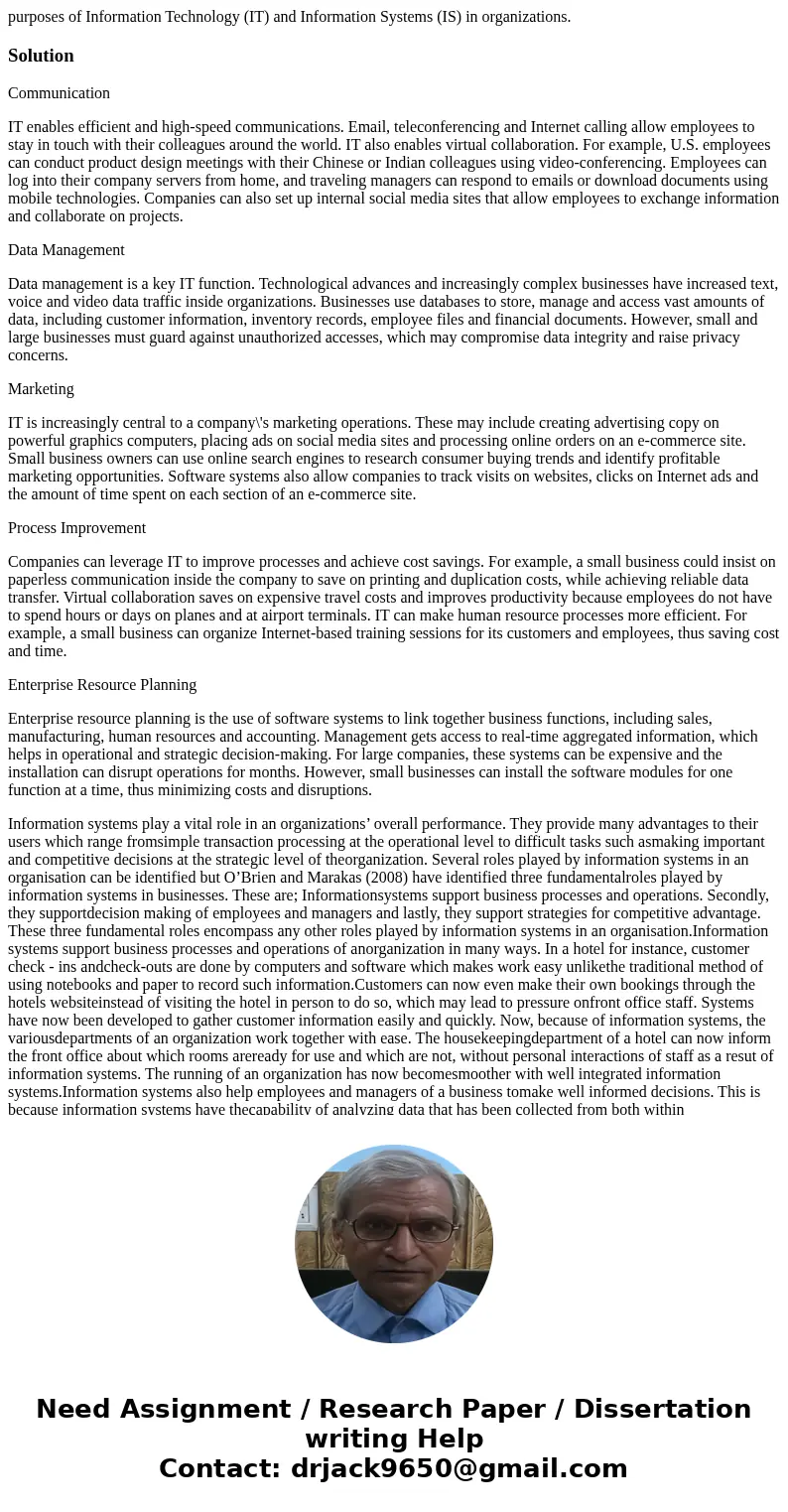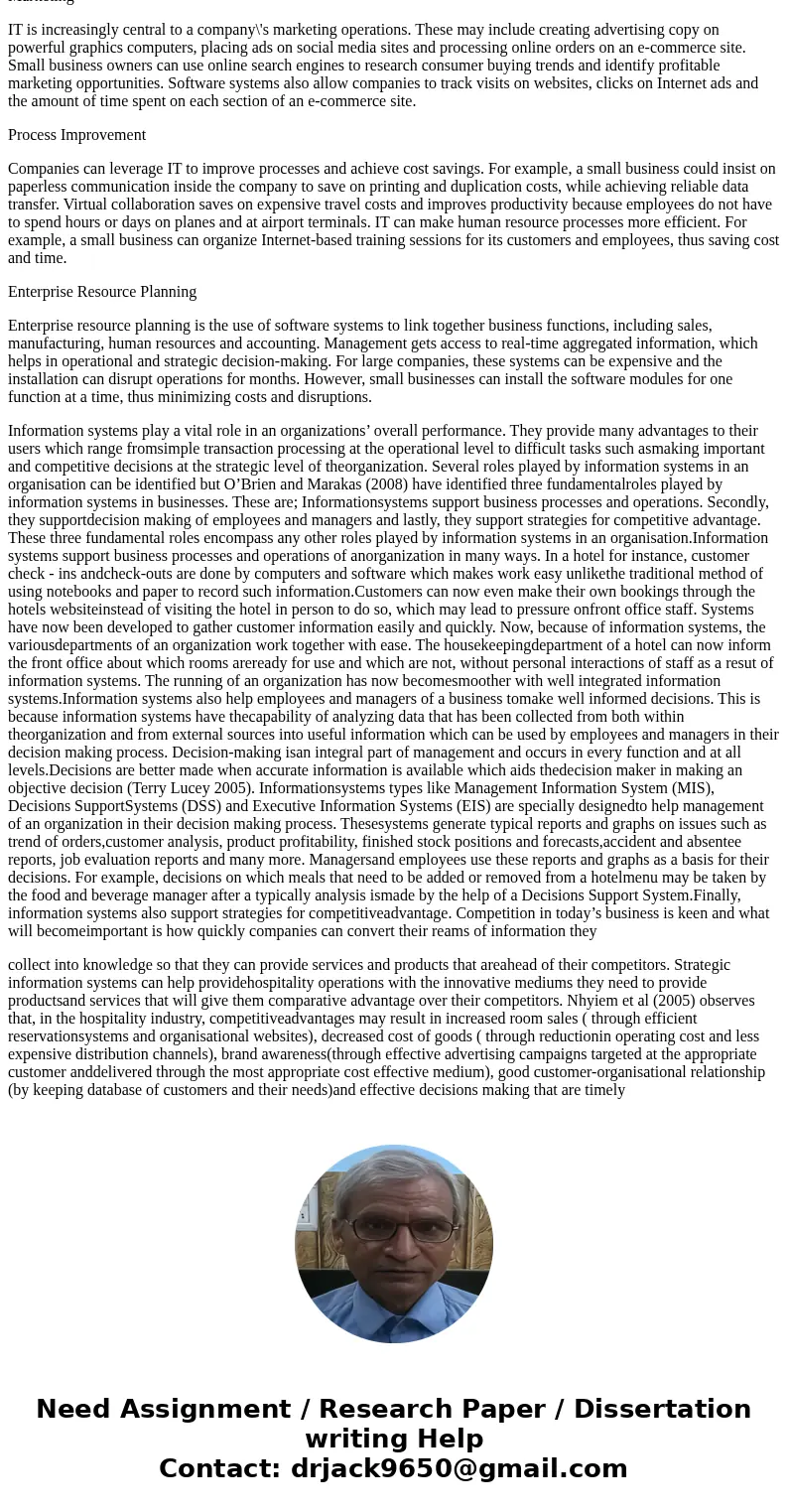purposes of Information Technology IT and Information System
purposes of Information Technology (IT) and Information Systems (IS) in organizations.
Solution
Communication
IT enables efficient and high-speed communications. Email, teleconferencing and Internet calling allow employees to stay in touch with their colleagues around the world. IT also enables virtual collaboration. For example, U.S. employees can conduct product design meetings with their Chinese or Indian colleagues using video-conferencing. Employees can log into their company servers from home, and traveling managers can respond to emails or download documents using mobile technologies. Companies can also set up internal social media sites that allow employees to exchange information and collaborate on projects.
Data Management
Data management is a key IT function. Technological advances and increasingly complex businesses have increased text, voice and video data traffic inside organizations. Businesses use databases to store, manage and access vast amounts of data, including customer information, inventory records, employee files and financial documents. However, small and large businesses must guard against unauthorized accesses, which may compromise data integrity and raise privacy concerns.
Marketing
IT is increasingly central to a company\'s marketing operations. These may include creating advertising copy on powerful graphics computers, placing ads on social media sites and processing online orders on an e-commerce site. Small business owners can use online search engines to research consumer buying trends and identify profitable marketing opportunities. Software systems also allow companies to track visits on websites, clicks on Internet ads and the amount of time spent on each section of an e-commerce site.
Process Improvement
Companies can leverage IT to improve processes and achieve cost savings. For example, a small business could insist on paperless communication inside the company to save on printing and duplication costs, while achieving reliable data transfer. Virtual collaboration saves on expensive travel costs and improves productivity because employees do not have to spend hours or days on planes and at airport terminals. IT can make human resource processes more efficient. For example, a small business can organize Internet-based training sessions for its customers and employees, thus saving cost and time.
Enterprise Resource Planning
Enterprise resource planning is the use of software systems to link together business functions, including sales, manufacturing, human resources and accounting. Management gets access to real-time aggregated information, which helps in operational and strategic decision-making. For large companies, these systems can be expensive and the installation can disrupt operations for months. However, small businesses can install the software modules for one function at a time, thus minimizing costs and disruptions.
Information systems play a vital role in an organizations’ overall performance. They provide many advantages to their users which range fromsimple transaction processing at the operational level to difficult tasks such asmaking important and competitive decisions at the strategic level of theorganization. Several roles played by information systems in an organisation can be identified but O’Brien and Marakas (2008) have identified three fundamentalroles played by information systems in businesses. These are; Informationsystems support business processes and operations. Secondly, they supportdecision making of employees and managers and lastly, they support strategies for competitive advantage. These three fundamental roles encompass any other roles played by information systems in an organisation.Information systems support business processes and operations of anorganization in many ways. In a hotel for instance, customer check - ins andcheck-outs are done by computers and software which makes work easy unlikethe traditional method of using notebooks and paper to record such information.Customers can now even make their own bookings through the hotels websiteinstead of visiting the hotel in person to do so, which may lead to pressure onfront office staff. Systems have now been developed to gather customer information easily and quickly. Now, because of information systems, the variousdepartments of an organization work together with ease. The housekeepingdepartment of a hotel can now inform the front office about which rooms areready for use and which are not, without personal interactions of staff as a resut of information systems. The running of an organization has now becomesmoother with well integrated information systems.Information systems also help employees and managers of a business tomake well informed decisions. This is because information systems have thecapability of analyzing data that has been collected from both within theorganization and from external sources into useful information which can be used by employees and managers in their decision making process. Decision-making isan integral part of management and occurs in every function and at all levels.Decisions are better made when accurate information is available which aids thedecision maker in making an objective decision (Terry Lucey 2005). Informationsystems types like Management Information System (MIS), Decisions SupportSystems (DSS) and Executive Information Systems (EIS) are specially designedto help management of an organization in their decision making process. Thesesystems generate typical reports and graphs on issues such as trend of orders,customer analysis, product profitability, finished stock positions and forecasts,accident and absentee reports, job evaluation reports and many more. Managersand employees use these reports and graphs as a basis for their decisions. For example, decisions on which meals that need to be added or removed from a hotelmenu may be taken by the food and beverage manager after a typically analysis ismade by the help of a Decisions Support System.Finally, information systems also support strategies for competitiveadvantage. Competition in today’s business is keen and what will becomeimportant is how quickly companies can convert their reams of information they
collect into knowledge so that they can provide services and products that areahead of their competitors. Strategic information systems can help providehospitality operations with the innovative mediums they need to provide productsand services that will give them comparative advantage over their competitors. Nhyiem et al (2005) observes that, in the hospitality industry, competitiveadvantages may result in increased room sales ( through efficient reservationsystems and organisational websites), decreased cost of goods ( through reductionin operating cost and less expensive distribution channels), brand awareness(through effective advertising campaigns targeted at the appropriate customer anddelivered through the most appropriate cost effective medium), good customer-organisational relationship (by keeping database of customers and their needs)and effective decisions making that are timely


 Homework Sourse
Homework Sourse